Ancient Coins
When I started collecting ancient coins I was stunned you could just, like, buy them. On ebay, via auctions, etc. Ebay, however, is full of fakes, and as a new collector you have no means of spotting a fake coin unless it's very obvious. So where do you go? Vcoins Vcoins is a sort of marketplace for ancient coins, where trusted dealers list their coins for sale. Almost every dealer there provides a lifetime guarantee that their coins are genuine, and will take back a coin if it's fake. You can find coins in all price ranges - from 10 dollar late roman bronze coins to gold coins costing thousands of dollars. Recommended :)

Another Philip I Arabs for the collection :) Common but in good shape

This coin is a tetrachalkon from Rhodes struck between 229 and 205 BCE. It's a pretty special coin - and I'll try to explain why :) Coins from Rhodes typically feature a rose on the reverse (back) - this is a play on words because the Greek work for rose is Rhodon - and Helios the sun god on the obverse (front). In fact, Helios was so important to Rhodes that they built a huge statue honouring him - the Colossus of Rhodes - on the entrance to the Harbour. It was 33 meters tall, roughly the same size as the Statue of Liberty today, and is recognized as one of the original wonders of the ancient world. This particular issue features Zeus, though. Why? Well, around 226 BCE Rhodes was struck by a devastating earthquake which toppled the statue and destroyed much of the city and harbour. This was a significant event, and Greek states from all over the Mediterranean sent help and offers to help rebuild the city and raise the statue again. According to Strabo, the statue had broken off at the knees. An oracle was consulted, and told the citizens of Rhodes not to rebuild it, and so they turned down this part of the relief effort. The most important and riches of Greek kings at this time was Ptolemaios III of Egypt. In fact he was so generous that the Rhodeians must have wanted to honour him in some way. And so they struck this coin - you see, Egyptian coins at this time almost always featured Zeus on the obverse in a very recognizable style which is replicated here. It is difficult to explain the obverse motif without this Egyptian connection, at least. I bought this coin some 6 years ago, and I don't see many of them around. It wasn't particularly expensive, but it has a special place in my collection because I find the circumstances for it being struck so fascinating. -------- **Obverse:** Laureate head of Zeus right **Reverse:** P - O, Rose with bud to right. Control: TE to left 18mm, 5.73g Ashton 234; HGC 6, 1469.

HADRIANVS - AVGVSTVS, laureate bust right, drapery on left shoulder COS - III, Roma standing right, holding spear and parazonium RIC II 160 Bought in 2017 for 25 GBP

Roman coinage from the punic wars is interesting, but quite a bit rarer is coinage from Carthage before it was razed. They minted quite exquisite coins in gold, silver and copper. Below is an example of such a copper coin! 30mm, 17.4g Obverse: Head of Tanit left, wearing wreath of grain ears and single-pendant earring. Reverse: Horse standing right, palm tree in background to left, ligate Punic T and S below. MAA 84b, Muller Africa, 154 - SNG Copenhagen 341-3 VF 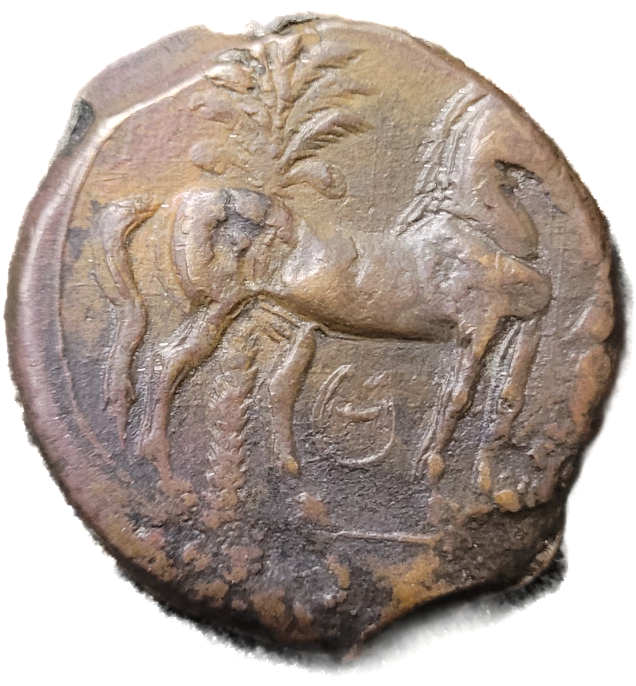

Obv: L AELIVS CAESAR. Bare head right. Rev: TR POT COS II / CONCORD. Concordia seated left on throne, holding patera and resting elbow upon cornucopia. RIC 436 (Hadrian). Weight: 3.23 g. Diameter: 18 mm. 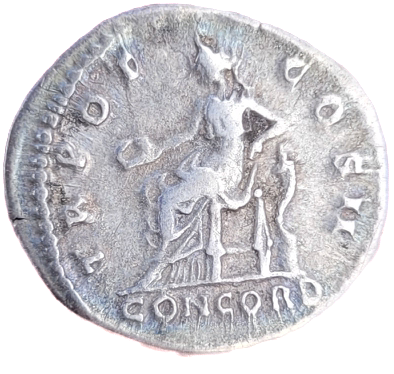 Lucius Aelius Caesar (13 January 101 – 1 January 138) was the father of Emperor Lucius Verus. In 136, he was adopted by the reigning emperor Hadrian and named heir to the throne. He died before Hadrian and thus never became emperor. After Lucius' death, he was replaced by Antoninus Pius, who succeeded Hadrian the same year.

A Latin alphabetic inscription on the coin bears the name "Esunertos," which can be translated as "mighty as the god Esos," (also spelled Esus) the statements said. The name itself is Gaulish

The head of Athena and an owl near an olive branch. Credit: Laura Lipcsei / Royal Ontario Museum

This is a follis - a silvered bronze coin, although the silver is almost worn off here - struck in the city of Nicomedia, now Izmit in Turkey, around 310-311 CE. Maximinus - called *Daia* - was the nephew of the emperor Galerius, but a series of complicated political decisions and maneuvers by Licinius I, Constantine, and his uncle ultimately led to his rebellion. Licinius quickly defeated him in two set battles and had him and his family executed. Maximinus II is a fairly easy emperor to collect, his coins are common and readily available in good grade, althoug perhaps not exactly as common as his rivals Constantine I and Licinius I. Only in bronze, though - silver and gold coins were in this period infrequently struck and this makes them rare and expensive. Folles from Nicomedia sometimes, like in this case, feature a CMH written as a ligature after the reverse legend. We don't know why - it could be a mark of value, it could be a shortened epithet honouring the emperor. ---- **Obverse:** IMP C GAL VAL MAXIMINUS PF AVG, Laureate bust right **Reverse:** GENIO AVGVSTI CMH 6.78g and 22mm RIC VI 66c

Obverse: CAESAR AVGVST PONT MAX TRIBVNIC POT, Bare head left. Reverse: P LVRIVS AGRIPPA IIIVIR AAAFF. , Large S C 12g and 27mm RIC 427 --- This coin still features the name and titles of the moneyer (P Lurius Agrippa) on the back, in the republican tradition, even if Rome is at this point quickly transitioning into the principate. His title of Tresvir Monetalis (IIIVIR) - properly *tresviri aere argento auro flando feriundo* or *three men for striking silber, gold and brass* - means that he was one of the officials appointed as mint magistrates for the year 7 BCE. This moneyer comes from a family (Lurius) of little renown, and so very little is known of him. He would have been around 30 years old when he held this office. From a cointalk discussion: *The other contemporary familiar Lurius was Marcus, cognomen not clearly recorded, who played a crucial role of Commander of the right wing of the Caesarean fleet under Octavian at least up to the battle of Actium in 31 BC. If Publius was approximately 30 in 7 BC, then he would have been a young child at the time of Actium, consistent with being a child of one of the top Caesarians, who were mostly young men.*

CAESAR-DICT • PERPETVO, veiled and laureate head of Julius Caesar right / P • SEPVLLIVS downward on right, MACER downward on left, Venus standing left, Victory in right hand, scepter in left; shield at feet behind. P. Sepullius Macer, moneyer. Crawford 480/13. Sydenham 1074. RSC 39. Good fine ex CNG 482/352 Issued from February up to the assassination of Caesar on March 15, 44. This coin represents one of the late lifetime portraits of Julius Caesar, with the title of a 'Dictator for life'. These portrait series were issued in large quantities to pay the troops gathered for Caesar's intended Parthian campaign. His assassination on the Ides of March prevented these plans. P. Sepullius Macer was the most prolific moneyer of 44 BC, striking the widest variety of Caesar portrait issues. Caesar is shown wreathed, sometimes also veiled, and his titles given as CAESAR IMP and CAESAR DICT PERPETVO, as seen on this specimen. The reverse image of Venus includes a number of minor design variants. The varying quality of portraiture and strike likewise indicate great haste of manufacture, perhaps in preparation for Caesar's projected Parthian war. Notice the weight, which is not abnormal for denarii from this age. They slimmed down considerably after Augustus' reforms. This particular specimen isn't in the greatest shape, nor in the worst. It retains all its core identifying features, like the veiled portrait of Caesar (one of the most important and iconic in ancient history, given its context and lead-up to his assassination), his controversial title(s), name, and origination of his gens in the depiction of Venus of which he claimed to be a direct descendant. All in all, a coin worthy of addition to any serious collector's hoard in my opinion. 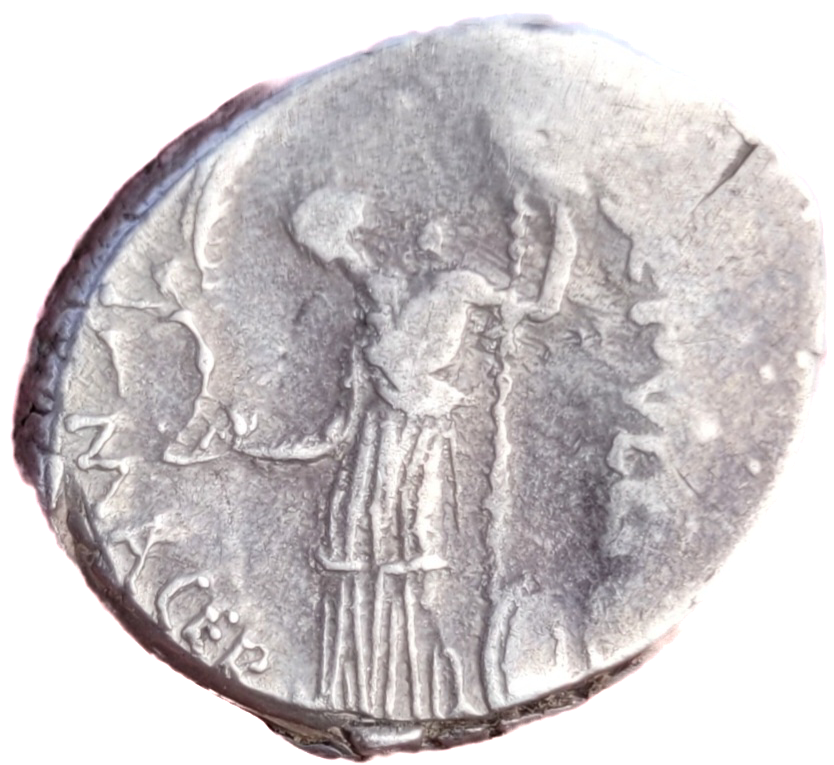 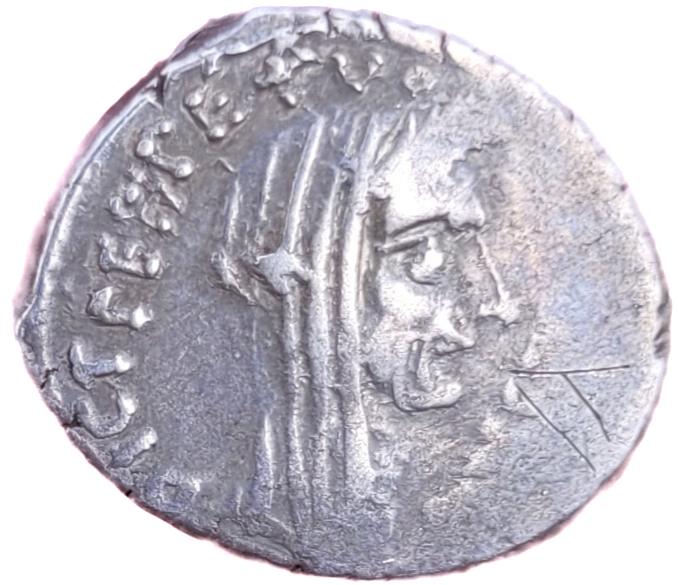 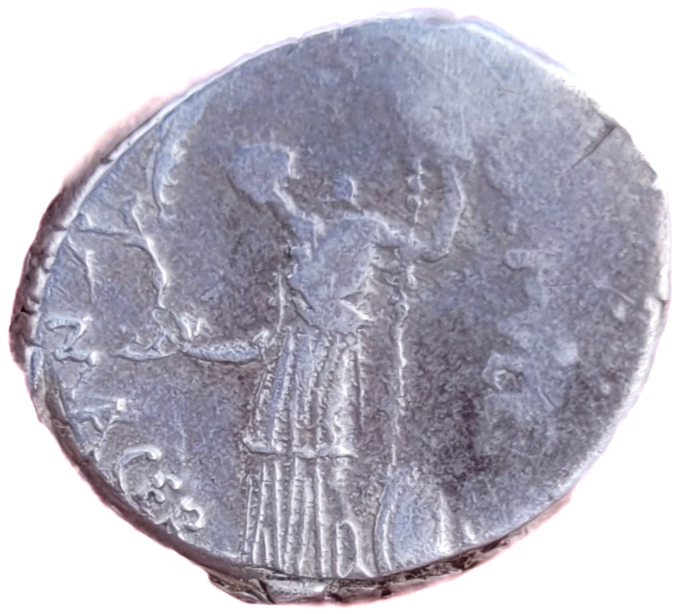

Apologies for the title, but that's exactly what this coin depicts. L. TITURIUS L.F. SABINUS. Denarius (89 BC). Rome. Obv: SABIN. Bareheaded and bearded head of King Tatius right; monogram to right. Rev: L TITVRI. Two soldiers, facing each other, each carrying off a Sabine woman in his arms. Crawford 344/1a. Condition: good-very fine. Weight: 3,7 g. Diameter: 19 mm. ====== The "Rape of the Sabine Women" is a legendary event in the early history of Rome, where the first generation of Roman men, lacking wives to establish families, organized a festival and invited neighboring Sabine people. During the festivities, the Romans abducted the Sabine women and forced them into marriage. The act led to a war between the Romans and Sabines, which eventually ended when the Sabine women, now wives and mothers of Roman children, intervened to broker peace, effectively merging the two communities. This narrative, albeit fraught with violence and patriarchal dynamics, was traditionally interpreted as a foundational myth explaining the growth and consolidation of Roman society. 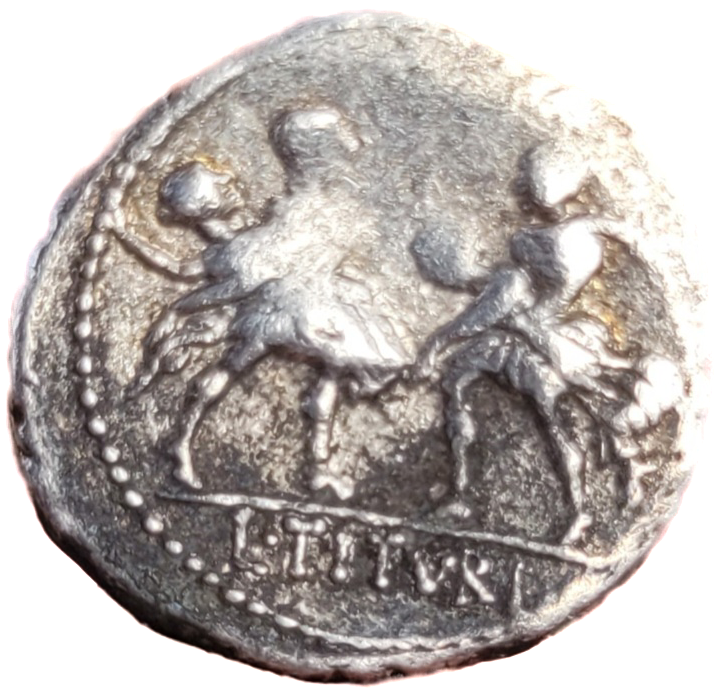

PTOLEMAIC KINGS OF EGYPT. Ptolemy III Euergetes (246-222 BC). Ae Tetrobol. Alexandreia. Obv: Diademed head of Zeus right, with horn of Ammon. Rev: ΠΤΟΛΕΜΑΙΟΥ ΒΑΣΙΛΕΩΣ. Eagle, with closed wings and head right, standing left on thunderbolt; filleted cornucopia to right; EP monogram between legs. Lorber B371; Svoronos 974; SNG Copenhagen 227-9. Condition: Near very fine. **Weight: 42.91 g.** Diameter: 38 mm.. avF This wasn't even the biggest or heaviest coin the Alexandria mint produced, if you can believe it. ====================== **Zeus-Ammon** is a fascinating result of religious syncretism between the Greek and Egyptian cultures. The deity represents a blend of the Greek god Zeus and the Egyptian god Amun (or Ammon). This syncretic deity emerged during the period following Alexander the Great's conquests, which facilitated cultural exchanges between Greece and Egypt. 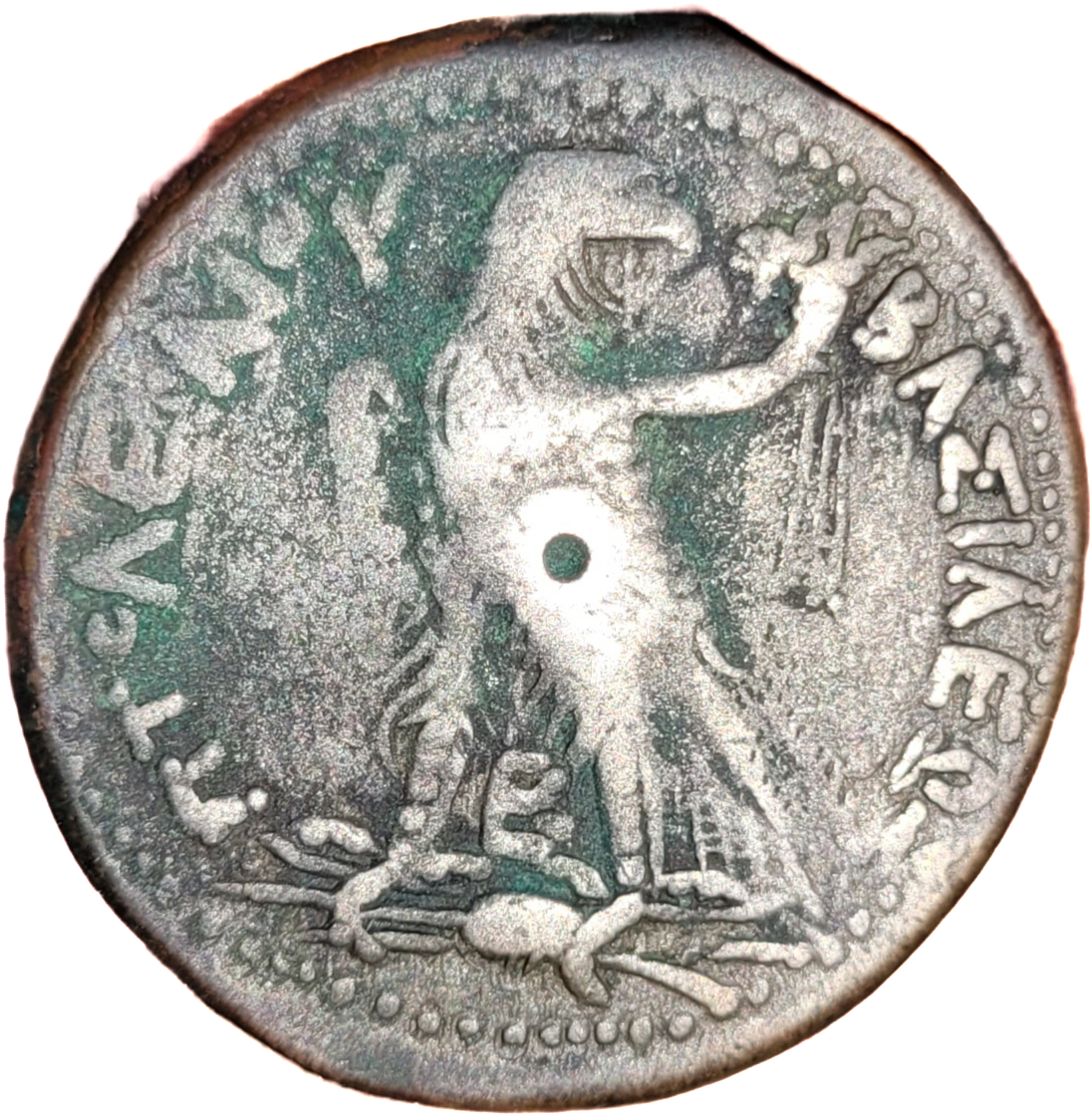

Obv: D N VETRANIO P F AVG. Diademed, draped and cuirassed bust right. Rev: CONCORDIA MILITVM / A - Δ / •TSA•. Vetranio standing facing, head left, holding labarum decorated with christogram in each hand; star above RIC 135. Condition: Very fine. Weight: 6.43 g. Diameter: 23 mm. Vetranio was a brief actor in the complex theatre of the Constantinian dynasty around 350 AD. Thrust into power by his troops amidst a period of political turmoil, he was a placeholder more than a ruler, swiftly yielding his title to Constantius II. His reign, though short-lived, reflects the tumultuous politics of the time and the military's significant role therein. Vetranio's peaceful cession of power helped to avert potential military conflict, aiding in a smoother transition of authority during a delicate period in the Roman Empire's history. 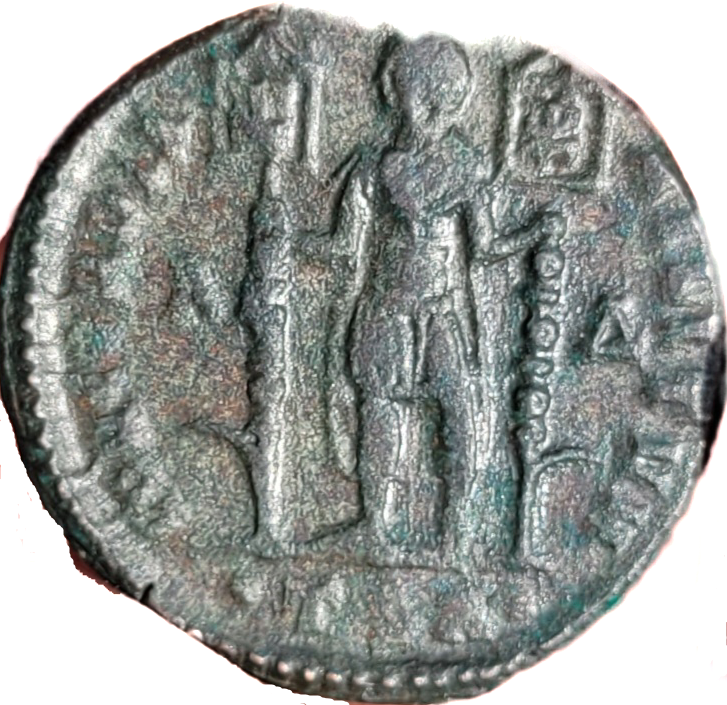

Mesembria, originally a Thracian settlement known as Menebria, became a Greek colony when settled by Dorians from Megara at the beginning of the 6th century BC, and was an important trading centre from then on and a rival of Apollonia (Sozopol). Remains from the Hellenistic period include the acropolis, a temple of Apollo, and an agora. A wall which formed part of the fortifications can still be seen on the north side of the peninsula. Bronze and silver coins were minted in the city from the 5th century BC and gold coins from the 3rd century BC. The town fell under Roman rule in 71 BC, yet continued to enjoy privileges such as the right to mint its own coinage. It is now the city of Nesebar in Bulgaria. If you're European you might know it better as the city just south of Sunny Beach. I don't actually remember when I bought this coins, but I've always really liked the design. The Crested Helmet is, of course, one of the most recognizable ancient Greek symbols, and I also like the symmetrical and aesthetically pleasing reverse with MEΣΑ inside the spokes of a wheel.

This is a fine little bronze issue struck in Antioch in modern day Syria under Flavius **Delmatius**, a Caesar of the Roman Empire and member of the Constantinian dynasty. Delmatius was the nephew of Constantine I. His father, also named Flavius Delmatius, was the half-brother of Constantine and served as censor. He was the brother of Hannibalianus. On 18 September 335, Delmatius the younger was raised to the rank of Caesar, with the control of Thracia, Achaea and Macedonia. He died in late summer 337, killed by his own soldiers. It is possible that his death was related to the purge that hit the imperial family at the death of Constantine, and organized by Constantius II with the aim of removing any possible claimant to imperial power other than the sons of the late emperor. ------- **Obverse:** FL DELMATIVS NOB C **Reverse:** GLORIA EXCERCITVS, two soldiers standing facing each other, each resting on spear and shield, a standard between them 15mm and 1.35g
Alright - time for some coin deals. I mostly know Roman & a bit of Greek coins, so here are some coins under 50 dollars which I consider "deals". ## Roman Coin deals * [Antoninus Pius denar with a lovely portrait for the price](https://www.vcoins.com/en/stores/savoca_gmbh__co_kg/234/product/antoninus_pius_138161_denarius_rome/1925459/Default.aspx) * [Nicely centered Caracalla-denar](https://www.vcoins.com/en/stores/tom_vossen/165/product/caracalla_198217_ad_ar_denarius_299_gm_195mm_rome_mint_struck_216_ad_ric_280c/1915073/Default.aspx) * [Heavy Galerius-follis with a fine portrait](https://www.vcoins.com/en/stores/tom_vossen/165/product/galerius_as_caesar_293305_ad_ae_follis_846_gm_28mm_treveri_mint_struck_2989_ad_ric_349b/1908930/Default.aspx) * [Chunky Diocletian-follis from Antioch](https://www.vcoins.com/en/stores/tom_vossen/165/product/diocletian_284305_ad_ae_follis_965_gm_28mm_antioch_mint_struck_3001_ad_ric_54a/1917232/Default.aspx) * [Heavy Maximianus Herculius follis in an characteristic style](https://www.vcoins.com/en/stores/tom_vossen/165/product/maximianus_herculius_286305_ad_ae_follis_982_gm_275mm_cyzicus_mint_struck_2956_ad_ric_10b/1875407/Default.aspx) * [Lovely sand-patinated Licinius bronze coin](https://www.vcoins.com/en/stores/aegean_numismatics/1/product/roman_empire_licinius_308324_bronze_ae3/1950564/Default.aspx) * [Perfectly round Licinius II follis in an interesting style](https://www.vcoins.com/en/stores/savoca_gmbh__co_kg/234/product/licinius_ii_caesar_317324_follis_cyzicus/1925440/Default.aspx) * [Licinius I with a really really pretty reverse](https://www.vcoins.com/en/stores/tom_vossen/165/product/licinius_i_308324_ad_ae_follis_344_gm_22mm_heraclea_mint_struck_3134_ad_ric_6/1922304/Default.aspx) ## Greek Coin deals * [Rhodes-hemidrachm with a rose reverse](https://www.vcoins.com/en/stores/tom_vossen/165/product/karia_rhodos_rhodes_circa_12588_bc_ar_hemidrachm_127_gm_12mm_uncertain_magistrate_cf_cng_elec_auc_383_lot_201/1950694/Default.aspx) * [Alexander the Great bronze issue](https://www.vcoins.com/en/stores/savoca_gmbh__co_kg/234/product/kings_of_macedon_alexander_iii_the_great_336323_bc__unit/1879945/Default.aspx) * [Very very old lion/star silver coin from Miletos](https://www.vcoins.com/en/stores/david_connors/41/product/ionia_miletos_ar9_obol_lion__stellate_incuse/1950539/Default.aspx) * [Bronze coin from Pergamon featuring Athena](https://www.vcoins.com/en/stores/aegean_numismatics/1/product/mysia_pergamon_13327_bc_ae19/1420648/Default.aspx) * [Helmet/spear coin from Macedon under Kassander](https://www.vcoins.com/en/stores/aegean_numismatics/1/product/kings_of_macedonia_kassander_305298_bc_bronze_ae13/1954583/Default.aspx) * [Ariobarzanes I, King of Cappadocia](https://www.vcoins.com/en/stores/aegean_numismatics/1/product/kings_of_cappadocia_ariobarzanes_i_9663_bc_silver_drachm/1921724/Default.aspx) Enjoy!

**Obverse:** IMP CM Q TRAIANVS DECIVS AVG, cuirassed bust with radiate head right **Reverse:** DACIA , Dacia standing left, holding draco standart ---- I have a couple of these silver coins celebrating the (re)conquest of Dacia, modern day Romania, under Trajan Decius. Dacia had been invaded by the Carpi from the 230s and forward, until the Philip I sent Decius to deal with them around 245 AD. He finally stabilized the area around 248 AD, and his troops then acclaimed him emperor. A short civil war ensued, Philip was killed near Verona in AD 249, and Decius was recognized by the Senate. He would rule for only a couple of years as he and his son were killed by Goths at the [Battle of Abritus](https://en.wikipedia.org/wiki/Battle_of_Abritus) in 251 AD. Dacia is holding a so-called Draco-standart, which was apparently a dragon-like battle-standard used by the Dacians. When they attacked on horseback, the flow of air would create a sort of frightening howl. Dacian horsemen were also used in the legions, and famously a company of Dacian horsemen with a Draco-standard were stationed in the UK close to Wales. Some people believe that the legend of King Arthur the Dragon grew from these Dacian knights being the only law and order around after the Romans left. Who knows, maybe they inspired the Welsh dragon too.

Julian was the last non-Christian ruler of the Roman Empire, and attempted to revive traditional Roman religious practices at the expense of Christianity. This caused him to be remembered as *Julian the Apostate* by the church. **Obverse:** Helmeted, diademed and cuirassed bust l., holding spear and shield. **Reverse:** VOT/ X/ MVLT/ X X in four lines within wreath I have this coin noted down as RIC VIII 220, but as it goes I haven't verified it :) It's fairly small at 17mm and 2.51g, but that's normal for the issue. I've always been partial to Julian, if only because he was by all accounts a clever and honest man. It's interesting to toy with the idea that things might have gone differently for Christianity or the Empire if he hadn't died after only 2 years on the throne from wounds sustained in battle against the Sasanids.

Obverse: GAL VAL MAXIMIANUS NOB CAES, laureate head right Reverse: GENIO CAESARIS, Genius Standing left, holding patera and cornucopia S K-P/ALE in exergue (Alexandria mint)  RIC 99a.
I got these 2 small coins from an antique store in the Seattle area and I'm pretty sure they said they were Roman. I have no idea if that's correct. Any help would be greatly appreciated. The roundish one is about the size of a US dime and the triangle one has its corners a little less than that. They seem quite small. Edit 1: On the first one, I think the suggestion for India and Mughal is the right direction considering these coins look very similar: https://en.numista.com/catalogue/madurai_dynasty-1.html https://rareindiancoins.com/home/1052-shah-alam-ii-falus-copper-coin-mughal-empire-coinage.html Edit 2: Then again, could the first coin be a pirate coin? The thickness and design could be cut weirdly like this: https://www.vcoins.com/en/stores/numiscorner/239/product/coin_spain_philip_iv_2_maravedis_1658__copper/1323544/Default.aspx

This is a follis - at this point in time a small bronze coin with thin silvering - stuck in Thessalonica in Greece in AD 324. 18mm and 3.3g. **Obverse:** CONSTANTINVS IVN NOB C, Laureate, draped and cuirassed bust left **Reverse:** VOT/·/X in three lines within wreath, TSBVI I have it noted down as RIC VII 128 - which I suppose is true enough, but RIC (Roman Imperial Coinage) is a reference which few people have actual access to, so many dealers and collectors just accept whichever number is noted down at face value and don't double check :) VOT X on the reverse refers to a vow to rule for 10 years. In reality, Constantine II was only ruler for 3 years - 337 to 340. This coin was struck when he was 8 years old.

**Sappho** from Mytilene on Lesbos is probably best known for giving her name to being a *lesbian*, but in fact wrote not (only) about love between women, but about love in general. In these fragments about the love of a young man, Atthis. ------ ### On Love and Desire (fragments) I …..You burn me….. II Remembering those things We did in our youth… …Many, beautiful things… III …Again and again…because those I care for best, do me Most harm… IV You came, and I was mad for you And you cooled my mind that burned with longing… V Once long ago I loved you, Atthis, A little graceless child you seemed to me VI Nightingale, herald of spring With a voice of longing…. VII Eros, again now, the loosener of limbs troubles me, Bittersweet, sly, uncontrollable creature…. VII ………..but you have forgotten me… VIII You and my servant Eros…. IX Like the sweet-apple reddening high on the branch, High on the highest, the apple-pickers forgot, Or not forgotten, but one they couldn’t reach… X Neither for me the honey Nor the honeybee… XI Come from heaven, wrapped in a purple cloak… XII Of all the stars, the loveliest… XIII I spoke to you, Aphrodite, in a dream…. XIV Yet I am not one who takes joy in wounding, Mine is a quiet mind…. XV Like the mountain hyacinth, the purple flower That shepherds trample to the ground… XVI Dear mother, I cannot work the loom Filled, by Aphrodite, with love for a slender boy… ------ The verse measure - the **Sapphic stanza** - consists of three 11-syllable verses of dactyls (long-short-short) and trochees (short-long) followed by a short five-syllable final verse. What greater honor can there be for a poet than to have a type of verse named after you? She was one of the 9 poets who were studied in the classical academies for almost 1000 years. Plato, who lived 200 years after Sappho, called her 'the tenth muse', and Horace - 500 years after her death - considered her almost divine. The poet Catullus, who is still read in our time, became widely famous for his translations of Sappho's poems. Unfortunately for all of us, the vast majority have been lost. However, in the last 15 years more and more fragments of her poems are coming to light due to new technology for analyzing fragile papyrus fragments. New poems by Sappho are therefore periodically published - approximately 2600 years after they were written. Isn't it wonderful how her poetry can create an emotional connection to a woman who lived before the Romans even got out of bed? ### The Coin The coin is a silver Diobol struck 400-350 BC in Mytilene. 10mm, 1.31g. **Obverse:** Laureate head of Apollo right **Reverse:** MYTI. Head of Aphrodite or Sappho right; uncertain symbol to left; all within incuse circle Personally, I find it appropriate that we do not know whether the reverse features one of the greatest love poets of all time - or the god of love she usually invokes in her poems.
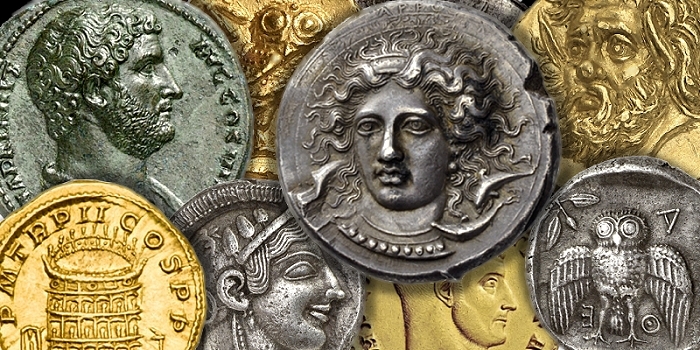 coinweek.com
coinweek.com
A perspective from coinweek on ancient coin collection, specifically I suppose on choosing a collection focus. My own collecting is not focused per se, I collect what I find cool. Still, over the years some themes have emmerged: * I like coins of **Philip I the Arab** because they are affordable in good grade and have many cool reverses * I like **small greek coins** because they often feature interesting gods and other themes and the variety is so great * I like coins from **Rhodes** as they feature a rose and generally look nice

**Miletos** was a Greek city in the area that was called Ionia in antiquity, and which is today part of Turkey. The ruins can be visited near the village of Balat, which lies approximately halfway between the holiday islands of Samos and Rhodes. Like so many other cities in the area, Miletos was founded in prehistoric times, when the Greek tribe called the **Ionians** colonized the area around 1000 BC. The period from around 1100 BC to 800 BC is often called "The Greek Dark Ages" - and it was indeed a dark time following the total collapse of the Mycenaean civilization. But after darkness comes light, and from 800 BC and henceforth the Greek cities of Anatolia were very successful in at least one thing; they had children and the children survived. It is believed that the population increased by a minimum of 4% each year. ### Let's go somewhere nice... All those people needed a place to live, and for the Greeks the solution was clear; colonization. From the 8th to the 6th century BC the Greek peoples - the Ionians, Dorians, Achaeans & Aeolians - founded thousands of cities around the Mediterranean (Fig. 1). 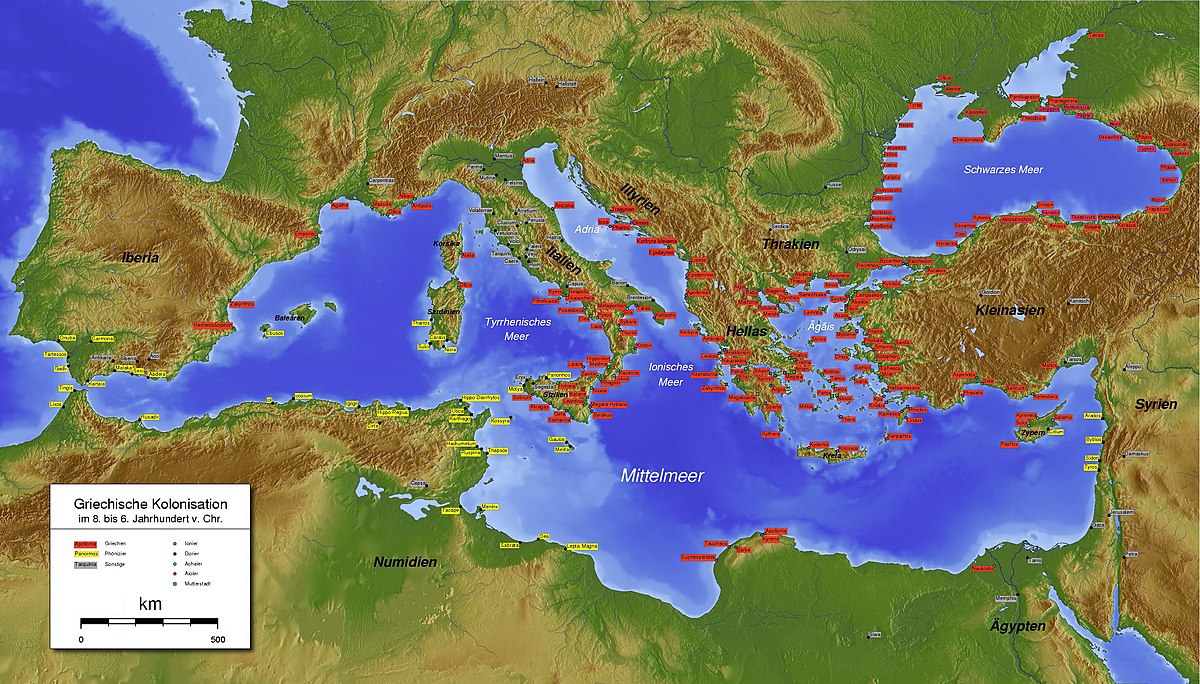 More city-states means more trade, and with more trade comes prosperity. And with prosperity comes the energy and time for other pursuits than toiling for your daily bread. ### The birth Thales - and philosophy And so, in Miletos around 624 BC, Thales was born - a man who can without exaggeration be called one of the most important people who ever lived. You see, Thales had a theory: *Everything - EVERYTHING - is made of water!* The earth obviously floats on water, and earthquakes are when the earth is moved by waves. Blood is water, and without blood you die, trees are water, because they grow when they are watered. If you burn off gas, it turns into water, and fog condenses into water. Metal is also a type of water, because when it is heated it melts, and water can clearly condense into earth - you could see this in real time when you looked at the river Meander and how the water over the years condensed and created new earth. To our modern minds, it seems absurd, of course. But you need to understand that Thales is the first (at least in the Western tradition) to even consider explaining nature without referring to gods and mythology. Who tried to explain nature *with nature*, so to speak. And he attempted to do this without having *a single scientific or philosophical concept* at his disposal. What an intellectual effort In that sense, he is the **first philosopher -** and the **first scientist**. And by the way, he is also considered to be the **first Greek mathematician**. ### The Coin The coin here is a small 9mm silver coin from Miletos, a diobol, with a roaring lion on the front and a sort of star pattern on the back. It weighs only 1.16 grams. **Obverse:** Forepart of lion left, head to right **Reverse:** Stellate pattern within incuse square It was struck somewhere between the end of the 6th and the beginning of the 5th century BC. - that is, while Thales was alive. SNG Kayhan 462-75

Currently on holiday with the family in France, came across a coin shop and went in to ask if they had ancient coins (not many do). To my delight they did, although in a fairly middle quality. Still, it was priced fairly and to reward the guy for pulling out the stuff for me I bought this Philip I antoninianus with a victory reverse for 30 euro.

No story today :) Just the coin: -------------- **Obverse:** Radiate head of Helios facing slightly right **Reverse:** APTEMΩN / P-O, rose with bud to right, hook to left; all within incuse square. Struck 170-150 BC in Rhodes. Struck to the so-called Plinthophoric standard, under the magistrate Artemon. 13.1mm, 1.16g. Jenkins 50; SNG Helsinki 658. VF
If you're not an experienced collector of ancient coins - or not yet a collector at all - finding and buying coins can be a fairly daunting task. As a new collector you should: * **Avoid Ebay until you're more experienced**. It is full of fakes, and positive feedback is meaningless. While you *can* find good deals there, you won't know them unless you have lots of experience. * **Use only trusted sellers** such as those on [vcoins](https://www.vcoins.com/en/) or [MA-shops ](https://www.ma-shops.com/). Vcoins is generally more used in the US, MA-shops is often used in Europe - but many sellers are present on both platforms. They typically all offer a lifetime 100% money back guarantee if a coins is found to be fake after they've sold it to you. Here are some good deals from vcoins to get you started: **Under $30** * This [Licinius I follis](https://www.vcoins.com/en/stores/tom_vossen/165/product/licinius_i_308324_ad_ae_follis_372_gm_24mm_heraclea_mint_struck_313_ad_ric_73/1909884/Default.aspx) has a pleasing obverse and reverse and a fair price point. * This [Sasanian drachm of Khusro II](https://www.vcoins.com/en/stores/zurqieh/171/product/sasanian_kingdom_khusru_ii_ad_591628_ar_drachm/1876143/Default.aspx) is a nice large silver coin of one of the most famous Sasanian kings. * This [Constantine I follis](https://www.vcoins.com/en/stores/tom_vossen/165/product/constantine_i_the_great_307337_ad_ae_follis_224_gm_20mm_cyzicus_mint_struck_3245_ad_ric_34/1909905/Default.aspx) features the popular camp gate reverse. * This [Kyzikos silver hemiobol](https://www.vcoins.com/en/stores/aegean_numismatics/1/product/mysia_kyzikos_480450_bc_silver_hemiobol/1871479/Default.aspx) has a nice stylized lion reverse and is **really old**, only maybe 150-200 years after the invention of coinage. **$30-50** * This [silver diobol from Miletos](https://www.vcoins.com/en/stores/savoca_gmbh__co_kg/234/product/ionia_miletos_late_6thearly_5th_century_bc_ar_diobol/1855516/Default.aspx) features a lion mostly on-flan and a really pretty incuse reverse pattern. Also very old :D * A [nice portrait of Aurelian](https://www.vcoins.com/en/stores/tom_vossen/165/product/aurelian_270275_ad_ae_antoninianus_361_gm_21mm_siscia_mint_struck_272274_ad_ric_225/1907348/Default.aspx), one of the most overlooked emperors. * Speaking of portraits, this [Gordian III](https://www.vcoins.com/en/stores/tom_vossen/165/product/gordian_iii_238244_ad_ar_antoninianus_345_gm_24mm_rome_mint_struck_240_ad_ric_71_corr/1906989/Default.aspx) has a nice quality to it. * A passable [Hadrian denarius](https://www.vcoins.com/en/stores/gert_boersema/25/product/hadrian_ad_117138_ar_denarius_18mm_323_g_rome_mint/1905091/Default.aspx) * A [provincial Augustus from Syria](https://www.vcoins.com/en/stores/zurqieh/171/product/syria_antioch_augustus_ae_22/1894322/Default.aspx) **$50-100** * An [evocative portrait of Trajan](https://www.vcoins.com/en/stores/zurqieh/171/product/roman_imperial_trajan_silver_denarius/1906398/Default.aspx) * A [heavy syrian silver tetradrachm of Trajan Decius](https://www.vcoins.com/en/stores/zurqieh/171/product/syria_antioch_trajan_decius_249251_ad_ar_tetradrachm/491393/Default.aspx) * A [lovely Maximinus Thrax](https://www.vcoins.com/en/stores/tom_vossen/165/product/maximinus_i_thrax_235238_ad_ar_denarius_293_gm_19mm_rome_mint_struck_236_ad_ric_14/1906745/Default.aspx) * A [decent Philip I antoninianus with an Annona reverse](https://www.vcoins.com/en/stores/london_ancient_coins/89/product/philip_i_244249_ar_antoninianus__r_annona/1806739/Default.aspx) * A [chunky Marcus Aurelius sestertius](https://www.vcoins.com/en/stores/savoca_gmbh__co_kg/234/product/marcus_aurelius_161180_sestertius_rome/1900487/Default.aspx) to hold while you read the Medidations perhaps. In general, it is important to do a bit of research before making your first purchase, mainly by comparing coins at the same price point and decising which coin looks better to you. Condition is typically more important than rarity, but there's no formal system to classify what looks good to you. In the end, beauty is in the eye of the beholder and you set your own goals :)

In antiquity, the Greek world extended far beyond what we think of today as Greece. Most of Anatolia, which is Turkey today, was Greek, for example - just as large parts of the western Mediterranean were colonized by industrious Greeks, with Sicily at the center stage. And in north-western Anatolia, in what was called Troas (after Troy), once lay a city called Birytis. And.. that's more or less *all* we know about Birytis. We don't know exactly where is was, it's not mentioned in any written sources. We only know it from coins, and the evidence suggests that it appears to have existed from acround 350-250 BC. **Monotonous Motifs** Virtually all coins from Birytis depic the same thing. On the obverse a male bust, with or without a beard, wearing a silly triangular hat. On the reverse a club surrounded by a laurel wreath and the letters **BI PY** for Birytis. The man with the hat is (a) **Kabeiros** - a kind of nature god who was worshiped in secret orgiastic dancing and drinking lodges, and who was alledgedly the son of the blacksmith god Hephaistos. But no one knows for sure, because the rituals were secret - and no account of them survives. **What about the silly hat?** We know a lot about the hat, though. It is a **pileus** - a shadeless felt hat, which was mostly used as a kind of traveling hat, but as a symbol of FREEDOM! In the Greek world, this is the hat which was presented to freed slaves. After receiving the pileus, the former slave was free and could, as it were, wear their hat as they pleased. This tradition was adopted by the Romans, and aftet the ides of March, Brutus struck a coin with a pileus and two daggers on it, to symbolize that with the murder of Julius Caesar they had struck a blow for freedom (and against tyranny). Unfortunately, I will never be able to afford that coin - in 2011 a nice copy was sold for USD 546,250, and prices have risen sharply since then. ** Pileus 2: Return of the Pileus** In the 18th and 19th centuries, when the bourgoisie became enamoured with ideals about liberty, equality and fraternity, they found inspiration in ancient ideals and practices. Only, they confused the pileus with the **Phrygian cap**, the red hat which became popular during the French Revolution(s). But maybe you'd have had fewer recruits with the pileus, as it is *quite silly indeed.* And who wants to look silly for the revolution? -------- **Obverse:** Head of Kabeiros left, wearing conical helmet; two stars above. **Reverse:** B I / P Y, Club within wreath. 18mm, 3.48g SNG von Aulock 1502-3; SNG München 168

**Diocletian**, Roman emperor from 284-305, was born Diocles - a Greek name - in the year 244 in Dalmatia, now the Balkans. Like so many others from the minor nobility he became a soldier - and at the age of 40 he was general of the 'Proctores Domestici', the cavalry unit belonging to the emperor's household. When the ruling emperor, Carus, was struck by lightning during a campaign against the Persians his two sons Carinus & Numerian inherited the throne. Numerian "mysteriously" died on his way to Rome, and it totally had nothing to do with Diocles being responsible for his safety at all. I swear, total coincidence. He didn't even want to be emperor. But, you know, when the army insists it'd be rude to refuse... **The Battle agains Carinus** Carinus was of course not happy, and he gathered an army and marched against Rome and Diocletian, as he now styled himself. The battle stood at Margus in Moesia (now Serbia), and initially it looked like Carinus' larger and more experienced force would make short work of Diocletian's army. But as they were preparing to flee the unexpected happned; Carinus was killed by one of his bodyguards, as revenge for Carinus seducing his wife. After this, Diocletian was hailed as emperor by the army which had nearly defeated him. **The Tetrarchy** As emperor, Diocletian was a great reformer. He had (correctly) identified that it was impossible for one man to hold together the vast Roman Empire, which was now both threatened on all fronts and by internal discord. His solution was not new; he divided power between 2 senior emperors, each with an adopted junior emperor under him. From 286-305 he thus ruled alongside Maximian 'Herculius', with Galerius and Constantius I 'Chlorus' as junior emperors. And then he abdicated, retired, and moved into a villa in Dalmatia to grow cabbages, a villa which nowadays forms the center of the city of Split in Croatia. Maximian also retired, in Campania south of Rome. **His Final Years** Diocletian is the only emperor of the third and fourth centuries who died a natural death, and he is the only emperor at all who voluntarily abdicated. And that is perhaps the greatest proof of how great a ruler he really was. After 50 years of chaos and civil war under 27 emperors, Diocletian ruled for 21 years before abdicating. Sadly, his system, the Tetrarchy, collapsed almost immediately. The Roman Empire was again thrown into civil war - and Diocles died sick, tired and broken on December 3rd 311. **The End of Realistic Portraiture on Coins** With Diocletian the era where coins reflect what an emperor looked like in reality is definitely over. Due to hyperinflation, portrait quality had steadily declined as early as under Gallienus, and coins under Carus, Carinus, Numerian and Diocletian have virtually identical portraits. Not even after Diocletian's coinage reform - where this follis is from - are there any attempts to make the emperors look distinct. In fact, realistic portraits are now a thing of the past for the next thousand years, after which the Renaissance kings begin to look to the rulers of antiquity as models - and to imitate their coins. **The Coin** This coins is a follis, a large coin measuring 28mm and weighing 10 grams. The reverse features the spirit of the Roman people - Genius Populi Romani. It was struck in Heraclea, now the small town of Marmara Ereğlisi in Turkey, about 90km west of Istanbul. **Obverse:** IMP C C VAL DIOCLETIAN P F AVG, Laureate bust right **Reverse:** GENIO POPVLI ROMANI, Genius standing left, holding patera and cornucopia RIC VI 19a

**Ephesos** was founded in the 10th century BC, in prehistoric Greek times, on the remains of the city of Apasa, which had served as the capital of the Arzawa Kingdom (Hipster Kingdom: Lasted for 800 years, you've never heard of it, inhabited Western Anatolia before it became cool). **Artemis Ephesia** Apasa had been the center of the worship of a Mother Goddess - Apasa may even mean 'Place of the Mother Goddess' - and this continued in Ephesus. But this time in the form of Artemis Ephesia - The Ephesian Artemis. Those of you who know Artemis probably know her as the twin sister of the sun god Apollo, the slim, lithe and athletic virgin moon and hunter goddess whose attributes are the bow and arrow. But **Artemis Ephesia** looks... completely different. She is actually - probably - identical to the mother goddess who was worshiped in Apasa before the Greeks came along. She's... a bee goddess! On her chest she has a cluster of bee eggs (or breasts) and her legs are bound together in a chrysalis. In Ephesus also stood one of the seven wonders of the world - the Temple of Artemis - whose priestesses were called Melissae - 'bees', a word that recurs in both the Latin name for lemon balm and the other herbs in the Melissa genus (because they attract bees), and in the name of Melissa, of course. **Herostratic Fame** The Temple of Artemis was built in 550 BC. and was burned down in 356 BC. - on the same night that Alexander the Great was born - by a man named Herostratus. If the name means something to you, dear reader, then it is only because of that. He burned down the Temple of Artemis to become famous - for good or for evil. An early example of "there's no such thing as bad press". The Ephesians executed him, of course, and were forbidden to mention his name under penalty of death. But the historian Theopompus wrote it all down, and Herostratus did become (in)famous. Although 'herostratic fame' is not exactly desirable. **The Coin** The coin here was struck sometime in the period 375-325 BC, so both Herostratus and the little Melissas - busy-bee priestesses - may have held it in their hands. It is 11mm and features Artemis on the front, and a bee on the back - and the letters E - Φ for Ephesus.

This antoninianus was struck under **Philip I Arabs** in Rome in 248 AD, and is part of a series of coins celebrating the 1000th anniversary of Rome. A *saeculum* was typically 100 years, and was regarded as the longest possible lifespan for a human. So every 100 years they would have games called the *Ludi Saeculares*, and in AD 248 they coincided with the millennial celebration. The coins struck to celebrate this occasion have a wide variety of cool reverses; wolves, stags, goats, hippos, lions, etc. They are cool and common. A very small subset of them have the animals going in the opposite direction to the norm. Maybe they were test issues, maybe it's just a coincidense. This coin has the stag going left instead of right and is, imho, really really pretty. **Obverse:** IMP PHILIPPVS AVG, radiate, draped & cuirassed bust right **Reverse:** SAECVLARES AVGG, stag walking left RIC 20, 3.88g, struck in Officina V(5)

** Obverse:** IMP C C VIB TREB GALLVS P F AVG, Radiate, draped and cuirassed bust right two pellets below **Reverse:** SAECVLLVM NOVVM, Roma seated facing on throne within hexastyle temple, holding sceptre This coin was struck in AD 251-252 in Antioch, and is classified as Sear 9648. I like this coin because it is basically a reissue of a coin struck only 4 years previously by Philip I Arabs celebrating the 1000th birthday of Rome. Saecullum Novum mean the *new milennium*. It must have been a real crowd pleaser, as the reverse was also used by Herennius Etruscus, Hostilian, and Volusian.






